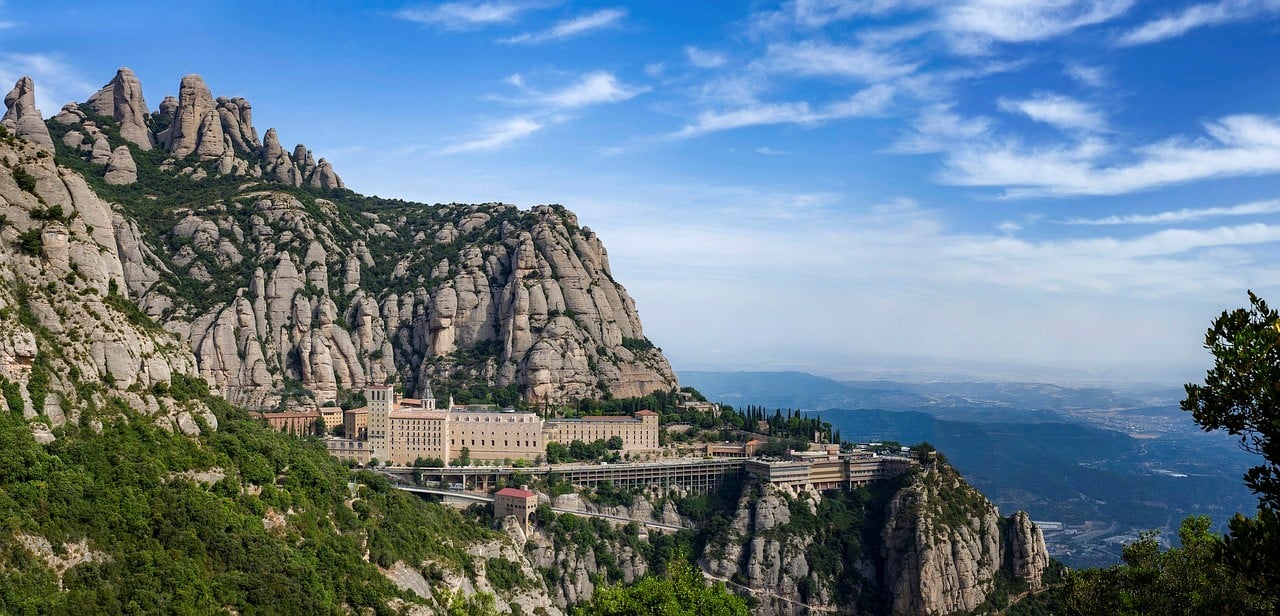
20 Oct Montserrat: the magic mountain of Barcelona
Visiting Monserrat is like discovering an extraordinary place. Located at an altitude of 1,236 meters, Montserrat is famous for its monastery, abbey and caves, as well as for its incredible landscapes and breathtaking views. If you are planning to travel soon to Barcelona and want to visit Montserrat, in this blog you will find everything you need to know to prepare your visit to Montserrat.
Montserrat: Symbol of Catalan identity
Montserrat, at a 1-hour drive from Barcelona, is a mountain massif famous not only for the beauty of its landscapes, but also for its high monastery. Its name comes from its amazing rock formations: it is a mountain that is 50 million years old. The Montserrat mountain range covers 4 municipalities: Collbató, El Bruc, Marganell and Monistrol de Montserrat, and the natural park covers an area of 3,630 hectares, with almost 2,000 hectares of nature reserve. A 100% natural landscape, the perfect place to breathe fresh air.
Legend also has it that it was the angels who came down to destroy a temple that the Romans had erected to Venus around 160 AD. The history of Montserrat is therefore strongly linked to spiritualism and the Christian religion. Perched on the side of a mountain, the Monastery of Montserrat dates back to the 16th century. Formerly a place of retreat for Benedictine monks, it is still a popular place of pilgrimage due to its mystical aura and its location in the heart of nature.
How to get to Montserrat from Barcelona
There are several ways to get from Barcelona to Montserrat. You can go by car, by public transport or through an organized excursion. You can drive up most of the mountain until you get close to the monastery, after which you can reach it on foot. There is also a cable car and a funicular at the top of the mountain.
By car from Barcelona to Montserrat
Driving from the centre of Barcelona to the Monastery of Montserrat, it will take you approximately one hour to cover the 60 kilometres that separate the two destinations. Depending on the area of Barcelona you are leaving from, you can choose between the C-16 or the AP-7 and the A2.
There are two parking areas in Montserrat. One is in Monistrol, next to the rack railway station, where you can make the climb up to the monastery leaving your car to one side and enjoy the views. The Monistrol car park is free, but you will have to pay for the rack railway service to get to Montserrat.
The other car park is at the top of the monastery. Places are limited, so we recommend you to arrive early. Parking costs 7 euros (over 30 minutes) per day, and 3.50 euros for a motorbike. Check prices.
Train and cable car or rack railway from Barcelona
FGC (Ferrocarrils de la Generalitat de Catalunya) trains leave Barcelona-Plaça Espanya station every hour for Montserrat. Line R5 (Barcelona-Manresa) connects with the Montserrat cable car and rack railway stations.
- For the Montserrat cable car, get off at the Montserrat Aeri stop.
- For the rack railway, get off at the Monistrol stop.
You can buy an all-inclusive TRANS MONTSERRAT ticket, which includes the return trip by train, the ascent to Montserrat on the rack railway, the possibility of using the 2 funiculars (Sant Joan and Santa Cova) and the possibility of visiting Montserrat.
You can also buy your train ticket and then a ticket for the AERI DE MONTSERRAT cable car for around 13 euros return.

Bus from Barcelona
The cheapest way to get from Barcelona to Montserrat is to take a bus from the company Autocars Julià, which has a regular line that leaves every day from Barcelona Sants bus station (C/ Viriat). These buses usually leave at 9.15am and take 1.30am to get there. The return journey usually starts at 5 p.m. in winter and at 6 p.m. in summer. The cost per journey is around 5 euros. Consult timetables.
A more convenient and interesting option for getting to Montserrat from Barcelona by bus is to book this excursion with a guide in English, which includes the rack railway and entrance tickets.
Other interesting excursions to Montserrat from Barcelona by bus and with a guide in Spanish are:
- Montserrat Monastery & Hiking Tour
- Montserrat Full Day Trip
- Self-Guides Montserrat Bus Tour
- Montserrat Day Trip
- Montserrat and Sagrada Familia Combo Tour
- Cardona and Montserrat Trip
What to see and do in Montserrat
There are many activities that can be done in a day in Montserrat. Some of them are visiting the Monastery, seeing the Moreneta, riding the funicular, enjoying the spectacular views, visiting the museum of Montserrat, listening to the children of the choir singing or hiking.
This is everything you can see and do in Montserrat:
Escala de l’Enteniment
Before reaching the monastery from the car park, you can see on the left side of the road a stone monument dedicated to the 13th century philosopher, poet and mystic Ramon Llull. The Escala de l’Enteniment, also known as the Stairway to Heaven, is a sculpture made of eight stone blocks representing the stone, the flame, the plant, the animal, the man, the sky, the angel and God.

Monastery of Santa Maria de Montserrat
The Monastery of Santa Maria de Montserrat is a Benedictine abbey founded in the 11th century by Abbot Oliba, although little remains of the original Romanesque buildings. The present Abbey, a mixture of Gothic and Renaissance architecture, dates from the 16th century and was rebuilt during the 19th century. The main facades of the Abbey and the Basilica were built in the 20th century. The abbey is home to about eighty monks and houses a library and a school. However, as an active monastery, many parts of the building are closed to the public. Only the Basilica, including the Moreneta, the atrium and the museum, can be visited.
The Basilica is open daily from 7 a.m. to 8 p.m., although the statue of the Moreneta is only accessible from 8 a.m. to 12.30 p.m. and from 12 p.m. to 6.30 p.m. The statue of the Moreneta is open to the public from 8 a.m. to 12.30 p.m. and from 12.30 p.m. to 6.30 p.m.
When you get to Montserrat, there is a flight of steps leading up to the monastery just opposite the rack railway station, between the bank and the souvenir shop. You can also follow the road around the town to the left (normally closed to vehicles), which also leads to the monastery. It is only a few minutes’ walk from the train station to the square in front of the monastery, where you will usually see a line of pilgrims queuing in front of the archway to the right of the building.

The Moreneta
La Moreneta (Virgin of Montserrat or Mare de Déu in Catalan) is a ninety-five centimetre polychrome statue of the Virgin and Child, which stands in a guided throne room behind the altar of the Basilica of Santa Maria de Montserrat. The statue, in Romanesque style, was carved in the 12th century and is one of the few statues of the Moreneta that exist in Europe.
To reach the statue, enter the monastery through the archway on the right of the building. It is easy to recognise the entrance because, unless you arrive very early, there is usually a line of pilgrims queuing. After entering the monastery, you pass through a series of chapels before reaching some stairs that lead to the opulent throne room where the statue is located.
When visiting the Moreneta, pilgrims often touch or kiss the orb, which protrudes through the glass screen that protects the rest of the statue. After leaving the throne room, you pass through a small chapel before reaching a passageway called the Ave Maria path, where you can light a candle in homage to the Moreneta.
The visit to the basilica or the statue of the Moreneta is free of charge, although there are places where you can leave a donation if you wish. Depending on the time of arrival, the queue to see the Moreneta can last between a few minutes and an hour.

Children’s choir of the Escolania of Montserrat
Another reason to visit the basilica is to listen to the world-famous Escolania children’s choir, which is one of the oldest choirs in Europe and dates back to the 14th century.
The choir performs every day except Saturdays, and if you wish to attend a performance, you must book in advance here. Making a reservation guarantees you access to the basilica for the performance, but does not reserve you a seat. If you have not booked online, you may be able to secure a seat at the Tourist Office, next to the rack railway station.
Times may vary due to public holidays and other events, so please check the schedule on the choir’s official website.
If you plan to see the children’s choir, the 10:36 train from Plaça d’Espanya usually gets you to Montserrat in time to see the choir perform at 13:00. However, I recommend that you arrive earlier if possible.
Montserrat Museum
The abbey also houses an extensive art museum with over a thousand pieces, most of which were collected by the monks or donated to the monastery.
In addition to paintings, there is a section dedicated to the Moreneta and a collection of archaeological pieces from the Middle East, including a 3,000-year-old sarcophagus from ancient Egypt.
You should spend about an hour visiting the museum, which is open daily from 10am to 5:45pm. Entry to the museum currently costs 8 euros and is included in the Tot Montserrat pass.
You will find more information on the museum’s website.

The Santa Cova
The Santa Cova is where it all began. According to legend, one Saturday afternoon in the year 880, a group of shepherds tending their flocks in the foothills of Montserrat were attracted by a celestial light emanating from a cave. The same thing happened on the following two weekends, when the shepherds returned, first with their parents and then with the clergy of Olesa de Montserrat.
On further investigation, a group of monks found a statue of the Virgin, which St Luke had carved in the early days of the Christian faith. When they tried to move it, the figure became incredibly heavy, so in the end they decided to leave it in the cave and build a church around it.
Whether the story is true or not, the chapel of the Santa Cova was built between 1696 and 1705. Inside the chapel, there is a small altar set into the bare rock with a replica of the statue of the Moreneta.
When the chapel was built, a path was cut into the rock to facilitate access to the chapel. The path is lined with a series of carvings created in the early 20th century by famous artists of the time, such as Antoni Gaudí, Josep Llimona and Josep Puig i Cadafalch.
To get to the Cova, you can either walk down or take the funicular railway, which runs from in front of the monastery to the start of the path, or walk. The way down to the Santa Cova is steep, so it is preferable to walk down and take the funicular back up.
The visit to the Santa Cova lasts approximately one hour and is open every day from 10:30 am to 2:00 pm.

Saint Michael’s Cross
In the Middle Ages, before the construction of the road, the cable car and the funicular railway, pilgrims reached the basilica by following a path from the nearby town of Collbató.
The Cross of Sant Michael marks the point from which pilgrims had their first view of the monastery. Today, the viewpoint where the cross stands offers one of the best views of Montserrat. On a clear day, you can see as far as the Pyrenees mountain range.
The path to the Sant Michael Cross starts next to the lower station of the Sant Joan Funicular and, although it is uphill, it is very easy. It takes about fifteen minutes to reach the Sant Michael Cross and is much less steep than the Santa Cova path.

Monastery of Santa Cecilia
In addition to the Monastery of Santa Maria de Montserrat, there are two other monasteries on the mountain of Montserrat. The oldest of these is the Monastery of Santa Cecília, a small Romanesque-style building dating from the 10th century.
The building functioned as a monastery until 1954, when it was deconsecrated and used as a hostel for hikers. It is now used as an art gallery with an exhibition by American artist Sean Scully. More information can be found here.
The monastery is about three and a half kilometres from the Monastery of Santa Maria de Montserrat. If you have a car, there is a car park open when the exhibition is open.

Hiking in Montserrat
One of the most popular activities on Montserrat is, of course, hiking. The mountains are home to a wide range of hiking trails ranging from short and relatively easy excursions to longer day hikes. To reach these trails, you can take the Sant Joan Funicular up from the Monastery of Montserrat, or on foot, either along a road to the top station or along a path with stairs.
When you arrive at Montserrat, you can visit the Tourist Office. There you can pick up a hiking map of the area which lists several routes, indicating their difficulty and length. There are also maps on the trail boards showing the different options.

These are our recommendations for things to see and do in Montserrat. We hope you enjoy your visit to the sacred mountain and that you like it as much as we do.
 655 789 186
655 789 186


No Comments